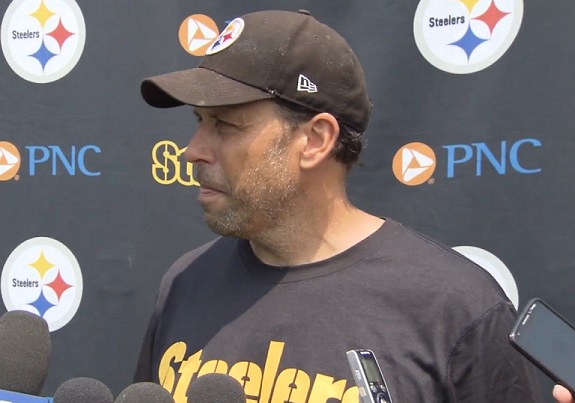If there’s one single, specific area of the Pittsburgh Steelers’ offense that has needed repair since time immemorial, it has been the team’s productivity in the red zone, where they have rarely been ranked in the top half of the league in terms of efficiency in converting trips inside the 20-yard line into touchdowns.
Last season, for example, they only ranked 19th in the league, despite finishing with the seventh-best scoring offense, converting on just under 52 percent of their red zone touchdown opportunities. And that was including a substantial mid-season boost during a winning streak that saw quarterback Ben Roethlisberger throw six touchdown passes in back-to-back games.
So it was certainly no surprise when offensive coordinator Todd Haley talked recently about the team’s desire to improve in that area a year after his offense boasted the leading passer, receiver, and rusher in the conference.
What was a bit of new information was the fact that Haley evidently changed up practice sessions during the course of the season last year, according to Mark Kaboly writing for the Pittsburgh Tribune-Review.
Kaboly writes that the Steelers altered their practice routine, “starting team drills during practice by placing the ball at the 2”, which is what we read about at the start of OTAs, and which seemed to take many by surprise as a response to the league changing the point after attempt rules, indicating their desire to work on two-point tries.
But, of course, a two-point conversion attempt is simply a goal-line football play. Practicing one simultaneously accomplishes the task of practicing for the other as well, which has seemingly been the mindset this offseason.
What has impressed me more about Haley’s strategy this offseason, however, has been in his ability to look beyond the red zone, a largely arbitrary demarcation determining when teams should be expected to score a touchdown, to realize that the issue goes deeper than in efficiently putting the ball in the end zone when you’re 80 percent of the way down the field.
According to Kaboly, Haley looked at his offense’s productivity level to assess their performance after the team had fallen to 3-3 earlier in the season, and he found that the offense left 37 points on the field, based on his determination that he should expect at least a field goal within the 35-yard line.
37 points in a span of six games is no small number. More specifically, that’s greater than two field goals per game. For the sake of convenience, we will round it off to six points per game. That could have been the difference in two of the Steelers’ five losses last season. A third game was lost by seven points.
Yes, the Steelers do need to become more efficient inside the 20-yard line in terms of coming away with touchdowns instead of field goals. That’s a four-point margin every trip inside that territory. But it’s also a three-point margin every time you get within the 35 and come up with nothing rather than a field goal.
Too often last season, the Steelers knocked themselves out of field goal range by taking untimely sacks, penalties, or other negative plays. If they cut that down enough to muster one more field goal per game, they vault themselves up to 30.25 points per game, less than .2 points per game behind the Green Bay Packers for the best scoring offense in the league last season.








